SPECTACLES
Refractive errors exist in all populations. More than a thousand years ago "glasses" made out of metal were used in India. These metal plates had dozens of small holes in the middle (Fig.27) and thus functioned as pinhole glasses. A very small hole neutralizes the refractive errors of the eye.

Fig.27. "Glasses" made of metal were used in India.
There are now numerous types of glasses. Since the selection is so large, lenses and frames should be fitted carefully, so the glasses are comfortable.
Lenses are made by many factories and thus are different even if their refractive power, the number of the lens, is same. If the optician chooses another factory's lenses, they may cause funny sensations even if the prescription did not change. Therefore, if you are happy with your present prescription ask the optician to choose similar or the closest similar lenses for your next glasses.
The tilt of the lenses is an important factor in fitting of the frames. Quite often uncomfortable glasses become comfortable after minor correction of the tilt. Glasses should always be made so that they are comfortable.
A 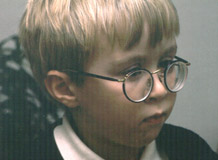 B
B 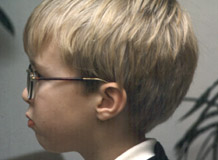
C  D
D 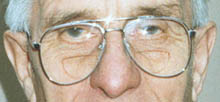
Fig.28a. Glasses are not always properly fitted. These pictures show common mistakes. A and B. Too weak a frame for -10 lenses and too little tilt of the lenses make this pair of glasses uncomfortable. The lenses should be tilted so that the line of gaze goes perpendicularly through the lens when reading. C. Too big frames are a common finding among people with intellectual disabilities. The frames touch the skin, lenses get therefore easily foggy and the frame may cause allergic reactions. The optic centre of the lens is in wrong place. D. When the lenses are bifocals, the reading part needs be placed at proper height in the lenses. In this pair they are uncomfortably low.

|
Fig.28 A. Lornette and B. pincenette are still useful (for example at hairdresser's). C. Halflenses are the lightest of all glasses. D. Bifocal lenses with a small near segment. E. Bifocal lenses with large reading segment. F. Trifocal lenses. G. Progressive lenses have a reading segment but the change from the distance correction to the near correction is gradual. The lines here depict the distortion of the picture in such a lens. |
Persons who use glasses all the time need bifocal or progressive glasses when they become presbyopic. It is, of course, possible to have two separate pairs of glasses if the change from one type of glasses to the other type of glasses is infrequent. Later one might want to have trifocal glasses or progressive glasses. The fitting of the lenses is critical. If the lower part of the glasses, the reading segment, is placed too low the person has to bend his neck backwards when reading.

Fig.29.
Important distances to be measured when reading lenses are prescribed for a presbyopic person. Even a work station with numerous visual targets can be arranged so that regular multifocal lenses function well. The lenses chosen by the optician/optometrist should fit the work and the desk organized to fit the lenses. Therefore it is important that the work station is adjusted before new glasses are fitted and that the ophthalmologist/optometrist and the optician get correct information on the structure of the work station - and the placement of computer and other visual targets at home.
Multifocal glasses are fitted best if the optician knows at which distances and at which levels the person has to look during the day (Fig.29). When these measurements are done it is crucial that the person sits as (s)he is used to sit at the desk or working place. The height of the chair and the desk are checked and the working materials arranged at suitable distances and at correct height, i.e. so low that they can be easily seen through ordinary lenses (bi- or trifocal or progressive).
If the reading segment is placed low the person is forced to hold his head tilted backwards with his chin up [Fig.30, 1]. Too strong a reading correction forces the person to bend closer to the text. This often causes lower back pain [Fig.30, 2]. In most working places the person has to see clearly materials on the desk, the terminal surface and a table or other information further away on the wall. The lenses can be chosen so that all these targets can be seen in a comfortable head posture.
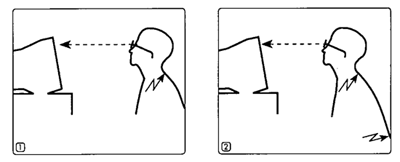
Fig.30.
Effect of lens design on ergonomy.
1. If the screen is placed too high and a presbyopic person has regular correction, bifocal or progressive, (s)he must have the chin uncomfortably high to look through the reading part of the lens. 2. If the reading part of a bifocal lens is too strong the person must lean forward to see the screen clearly. This causes lower back pain.

Fig.30.
3. Changing the gaze from the screen to the documents requires nodding and increases neck pain. 4. Even with 'special' progressive near vision lenses nodding is present.
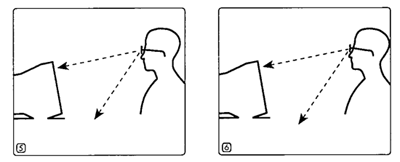
Fig.30.
5. By placing the screen lower head posture becomes comfortable. There is little difference between special near vision lenses (5) and regular progressive lenses (6).
It is possible to tint the lenses in order to decrease photophobia caused by retinal diseases or opacities in the lens or cornea. Since it is difficult to choose the colour and the darkness of the lenses in the shop, it would be helpful if the optician would lend several demonstration lenses for a few days. The lenses could be used indoors and outdoors in bright sun light, in shade, during twilight and cloudy weather to find out the best ones.
Contact lenses are used increasingly often. Soft contact lenses are especially useful as sport glasses. They have to be cleaned carefully. If the eyes are irritated or the person has a common cold, it is best to use regular glasses in order to avoid corneal infections. A practical solution is to use disposable contact lenses, lenses that are used only nce. then there is no risk of infection and no problems of cleaning and desinfection.
You have certainly seen a number of articles about refractive surgery and how the cornea can be modified by surgery so glasses are no longer necessary. These operations cannot correct all refractive errors and sometimes the scars of some of these operations may decrease vision may disturb at night when the pupil is large. The quality of vision, especially contrast sensitivity, may not be as good as it was originally. Many who want to get rid of their glasses are mildly myopic. They do not consider that if they get the refraction corrected for distance vision, they will need reading glasses when they become older. With myopic eyes one can read without glasses even when old. It is also important to remember that after some operations it is necessary to have glasses all the time when outdoors to reduce the risk of scar formation.
It is not generally known that refractive surgery may cause problems in the alignment of the eyes, the person may develop strabismus. A typical situation is a person with myopia -3.0 diopters who has always read without glasses. After refractive surgery he did not need glasses for seeing at distance but needed reading lenses because otherwise he had intermittent diplopia, crossed eyes part of the time. He could not accept half frames so he now has to use expensive progressive lenses instead of the simple -3.0 lenses he used before the operation.